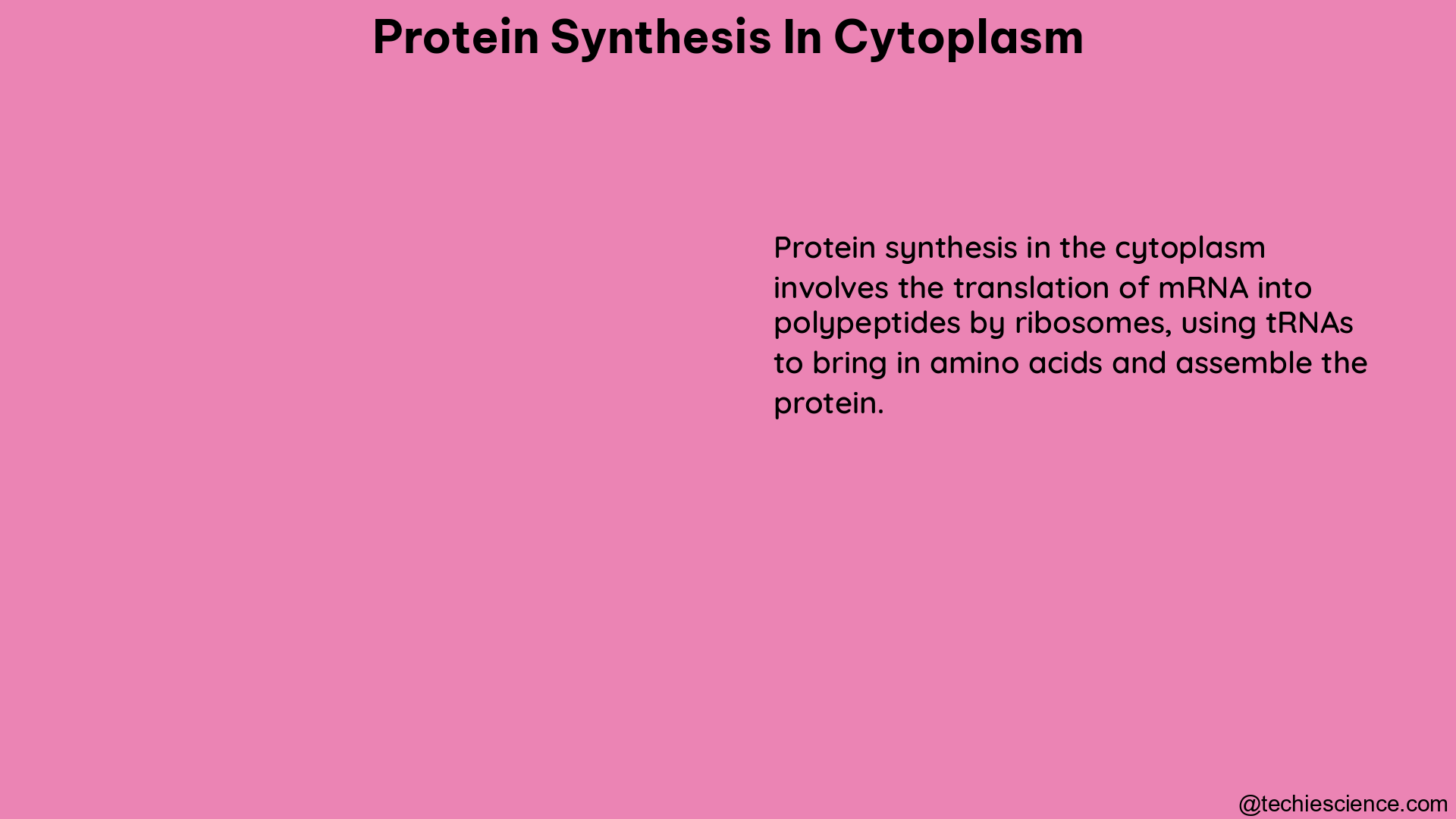Protein synthesis in the cytoplasm is a complex and dynamic process that involves the intricate coordination of various molecular players, including messenger RNA (mRNA), transfer RNA (tRNA), and ribosomes. This process is the cornerstone of cellular function, as it enables the translation of genetic information into the functional proteins that drive the diverse activities within a cell.
The Ribosome: The Protein Synthesis Factory
At the heart of protein synthesis in the cytoplasm is the ribosome, a large and intricate molecular machine composed of both RNA and proteins. Ribosomes are responsible for the translation of mRNA into polypeptide chains, which are then folded and modified to form the final functional proteins.
The ribosome is a highly complex structure, consisting of two subunits: the small subunit (30S in prokaryotes, 40S in eukaryotes) and the large subunit (50S in prokaryotes, 60S in eukaryotes). These subunits work in coordination to facilitate the step-by-step process of protein synthesis.
The Ribosome’s Role in Protein Synthesis
-
mRNA Binding: The small ribosomal subunit binds to the mRNA molecule, recognizing the start codon (AUG) and positioning the mRNA for translation.
-
tRNA Recruitment: The large ribosomal subunit then recruits the appropriate tRNA molecules, each carrying a specific amino acid, to the ribosome. The tRNA anticodon matches the codon on the mRNA, ensuring the correct amino acid is added to the growing polypeptide chain.
-
Peptide Bond Formation: The ribosome catalyzes the formation of a peptide bond between the amino acid on the incoming tRNA and the amino acid on the growing polypeptide chain.
-
Translocation: The ribosome then moves along the mRNA, one codon at a time, adding new amino acids to the polypeptide chain.
-
Termination: When the ribosome reaches the stop codon on the mRNA, it releases the completed polypeptide chain and dissociates from the mRNA.
The speed and efficiency of this process are remarkable, with ribosomes capable of synthesizing proteins at a rate of up to 20 amino acids per second in prokaryotes and 5-10 amino acids per second in eukaryotes.
Quantifying Protein Synthesis Rates

Researchers have developed several techniques to measure the rate of protein synthesis in the cytoplasm, providing valuable insights into this essential cellular process.
Ribosome Profiling
Ribosome profiling is a powerful technique that allows researchers to determine which mRNAs are actively being translated and at what rate. This method involves isolating ribosomes from cells and sequencing the mRNA fragments associated with them. By analyzing the distribution and density of these ribosome-protected mRNA fragments, researchers can calculate the translation rate for specific mRNAs.
For example, a study using ribosome profiling in the bacterium Escherichia coli (E. coli) found that the average protein synthesis rate was approximately 10 amino acids per second.
Metabolic Labeling
Another approach to quantifying protein synthesis is metabolic labeling, which involves labeling newly synthesized proteins with a radioactive or fluorescent tag. This allows researchers to measure the amount of protein produced over time.
A study using metabolic labeling in mammalian cells found that the average protein synthesis rate was approximately 2-3 picograms (pg) of protein per cell per hour.
Factors Influencing Protein Synthesis Rates
The rate and efficiency of protein synthesis in the cytoplasm can be influenced by a variety of factors, including:
-
Amino Acid Availability: The availability of the necessary amino acids, which serve as the building blocks of proteins, can impact the rate of protein synthesis.
-
tRNA Abundance: The abundance and availability of the appropriate tRNA molecules, which carry the amino acids to the ribosome, can also affect protein synthesis rates.
-
mRNA Stability: The stability of the mRNA molecule, which serves as the template for protein synthesis, can influence the duration and efficiency of the translation process.
-
Translational Regulators: Various regulatory proteins and small molecules can interact with the translation machinery, either enhancing or inhibiting protein synthesis.
-
Cell-type Specific Regulation: Protein synthesis is often regulated in a cell-type-specific manner, allowing cells to fine-tune their protein production to meet their unique functional requirements.
Specialized Techniques for Protein Synthesis Quantification
In addition to ribosome profiling and metabolic labeling, researchers have developed other techniques to quantify protein synthesis in the cytoplasm:
Single-cell Protein Quantification
Advances in single-cell analysis have enabled the real-time quantification of protein expression at the individual cell level. This approach, known as single-cell protein quantification, allows researchers to study the heterogeneity of protein synthesis within a population of cells.
Fluorescence-based Techniques
Fluorescence-based techniques, such as fluorescence recovery after photobleaching (FRAP) and fluorescence correlation spectroscopy (FCS), can be used to measure the dynamics and kinetics of protein synthesis in living cells.
Mass Spectrometry-based Approaches
Mass spectrometry-based techniques, including stable isotope labeling by amino acids in cell culture (SILAC) and pulsed SILAC, enable the quantification of protein synthesis rates by tracking the incorporation of labeled amino acids into newly synthesized proteins.
Conclusion
Protein synthesis in the cytoplasm is a complex and dynamic process that is essential for cellular function. By understanding the mechanisms and factors that influence protein synthesis rates, researchers can gain valuable insights into the regulation of gene expression, cellular homeostasis, and the development of therapeutic interventions targeting protein synthesis pathways.
References:
- Real-time quantification of protein expression at the single-cell level. Nature Communications. 2016.
- Protein Synthesis Analogy | mRNA, Ribosomes & Translation – Lesson. Study.com.
- Quantifying Absolute Protein Synthesis Rates Reveals Principles Underlying Allocation of Cellular Resources. Cell. 2014.
- Cell-type-specific quantification of protein synthesis in vivo. Nature Cell Biology. 2021.
- Ribosome profiling: global views of translation. Nature Reviews Genetics. 2012.
- Fluorescence-based techniques for measuring protein synthesis rates in living cells. Nature Protocols. 2014.
- Stable isotope labeling by amino acids in cell culture for quantitative proteomics. Nature Protocols. 2006.

Hi…I am Sadiqua Noor, done Postgraduation in Biotechnology, my area of interest is molecular biology and genetics, apart from these I have a keen interest in scientific article writing in simpler words so that the people from non-science backgrounds can also understand the beauty and gifts of science. I have 5 years of experience as a tutor.
Let’s connect through LinkedIn-